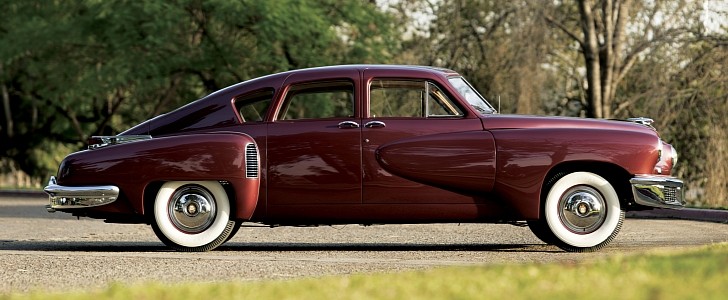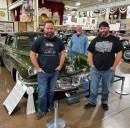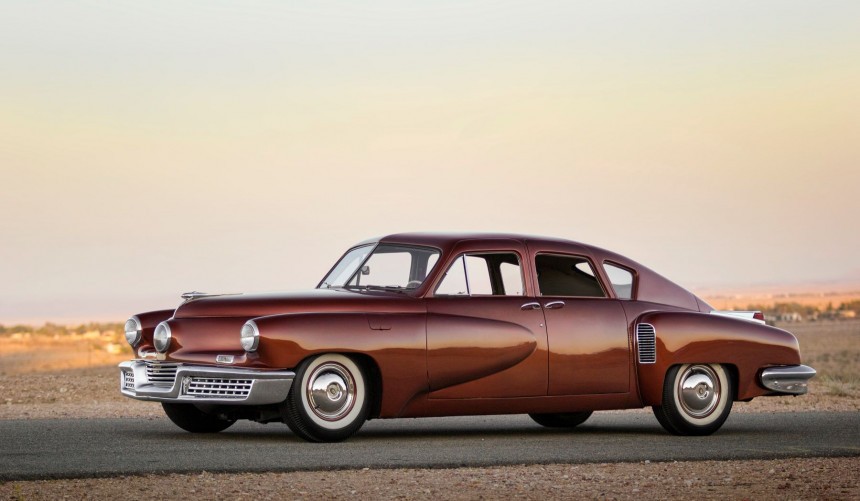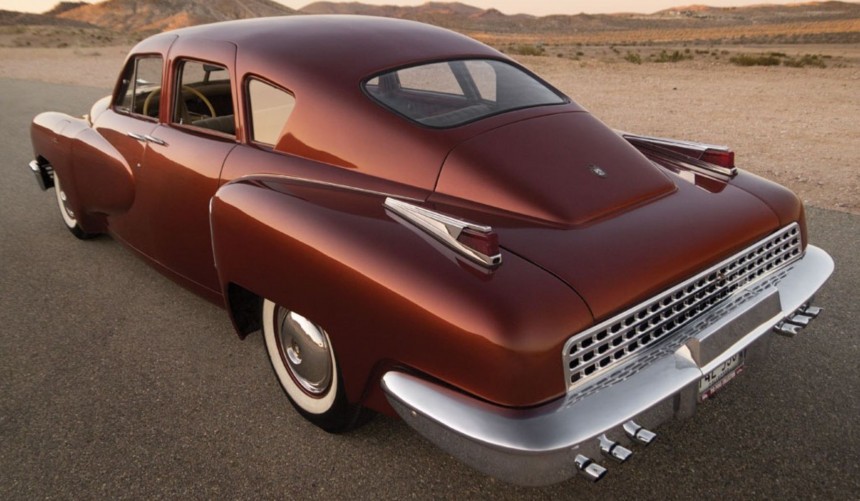Sean and Mike Tucker are identical twins who happen to be the great-grandsons of Preston Tucker. In collaboration with a noted collector and historian, they have embarked on a quest to preserve the legacy of Preston and the eponymous Tucker ‘48.
At the end of WWII, American automakers picked up where the left off, making only small updates to what they had offered in 1941. Tucker envisioned the first all-new American car in 50 years, and it would start with safety. The driver is protected by having the steering box mounted behind the front suspension, with a collapsible steering column taking the impact.
With all controls within easy reach, the padded dash included a reinforced "crash chamber” to catch and surround passengers. Protected by an integral roll bar and a perimeter frame, a test driver walked away after flipping car #27 three times going 95 mph at Indianapolis. Not only was the windshield laminated for safety, but it was also spring-loaded to pop out in an accident. Night driving was also made safer thanks to the center headlight that pivots in the direction of your turn. Sean explains these in detail in a walkaround video of the Tucker collection of the AACA museum in Hershey, PA.
Initially, power was to come from a 589 in (9.65L) flat-six. Mounted transversely behind the rear axles, the goal was to offer 150 horsepower without cams. High pressure oil was used to operate the valves, predating Koenigsegg’s Freevalve by 84 years. After a year of development, it proved too complex for the day, as the 24v starter needed almost 60 volts and patience to get running.
Bell Helicopter was poised to introduce a lightweight, air-cooled 335 in (5.4L), so Tucker and his team redesigned it for automotive use with liquid cooling and hardened internals. It proved to easily handle a wide-open dyno run of 150 hours, the equivalent of 18,000 miles of city use. To see how it stacks up to modern testing, the brothers strap car #34 to a modern chassis dyno to show us what it really makes.
Only 98 engines were produced, and the last one was sold as a display after the bankruptcy. Realizing it had never been started, they gave it a proper break-in before becoming the finishing piece of car #50, the last production car.
Instead of coils or leaf springs, Tucker worked with Firestone to develop “Torsilastic” suspension. Rubber of varying elasticities was molded in unique cannisters to offer a comfortable ride. They were improved along the way, with small changes in each car adding up to major differences between early and late builds.
Rotting away over the years, it has left many owners unable to enjoy their cars. In order to prepare car #44 for Pebble Beach, they used original engineering blueprints along with modern manufacturing to manufacture new (and pricey) replacements.
Building a car this forward-thinking needed tons of cash, so Tucker took his company public in one of the world’s first speculative IPOs. This was followed by traveling the country selling dealers on the idea and using their deposits to fund development. This was needed because automakers pressured the banks to avoid lending to him.
The most ingenious program was selling accessories to waiting customers. Parts like their innovative radio, seat covers, and even the heater were mailed to customers, and the team has discovered NOS examples still in their box.
This prompted the SEC to investigate Tucker’s financials, probably at the behest of Detroit’s power players. It was a perfect storm of industrial collusion and scathing journalism that killed this innovative machine, so we’re glad the family is telling these stories for future generations.
With all controls within easy reach, the padded dash included a reinforced "crash chamber” to catch and surround passengers. Protected by an integral roll bar and a perimeter frame, a test driver walked away after flipping car #27 three times going 95 mph at Indianapolis. Not only was the windshield laminated for safety, but it was also spring-loaded to pop out in an accident. Night driving was also made safer thanks to the center headlight that pivots in the direction of your turn. Sean explains these in detail in a walkaround video of the Tucker collection of the AACA museum in Hershey, PA.
Initially, power was to come from a 589 in (9.65L) flat-six. Mounted transversely behind the rear axles, the goal was to offer 150 horsepower without cams. High pressure oil was used to operate the valves, predating Koenigsegg’s Freevalve by 84 years. After a year of development, it proved too complex for the day, as the 24v starter needed almost 60 volts and patience to get running.
Only 98 engines were produced, and the last one was sold as a display after the bankruptcy. Realizing it had never been started, they gave it a proper break-in before becoming the finishing piece of car #50, the last production car.
Instead of coils or leaf springs, Tucker worked with Firestone to develop “Torsilastic” suspension. Rubber of varying elasticities was molded in unique cannisters to offer a comfortable ride. They were improved along the way, with small changes in each car adding up to major differences between early and late builds.
Rotting away over the years, it has left many owners unable to enjoy their cars. In order to prepare car #44 for Pebble Beach, they used original engineering blueprints along with modern manufacturing to manufacture new (and pricey) replacements.
The most ingenious program was selling accessories to waiting customers. Parts like their innovative radio, seat covers, and even the heater were mailed to customers, and the team has discovered NOS examples still in their box.
This prompted the SEC to investigate Tucker’s financials, probably at the behest of Detroit’s power players. It was a perfect storm of industrial collusion and scathing journalism that killed this innovative machine, so we’re glad the family is telling these stories for future generations.




























